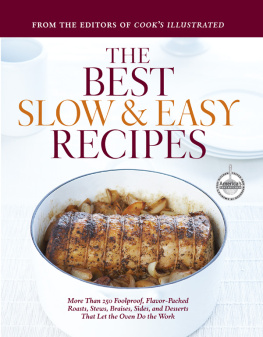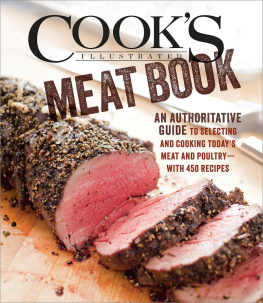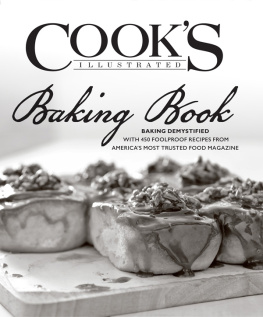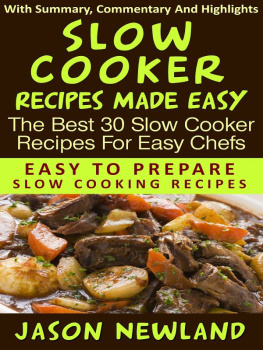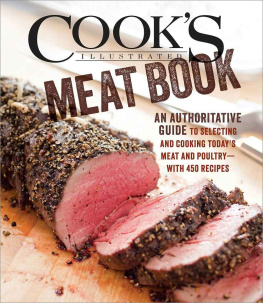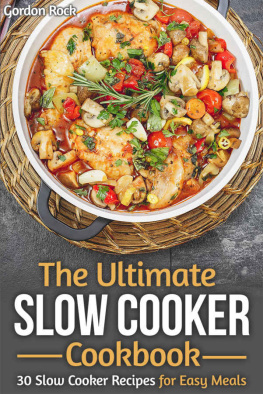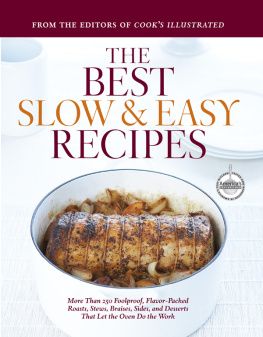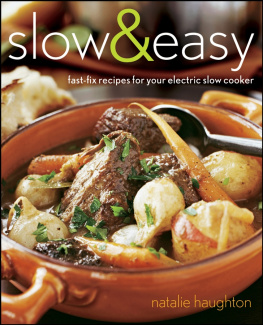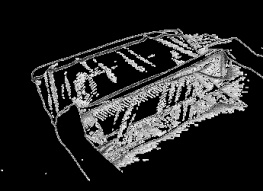Cooks Illustrated - The Best Slow and Easy Recipes
Here you can read online Cooks Illustrated - The Best Slow and Easy Recipes full text of the book (entire story) in english for free. Download pdf and epub, get meaning, cover and reviews about this ebook. year: 2013, publisher: Americas Test Kitchen, genre: Home and family. Description of the work, (preface) as well as reviews are available. Best literature library LitArk.com created for fans of good reading and offers a wide selection of genres:
Romance novel
Science fiction
Adventure
Detective
Science
History
Home and family
Prose
Art
Politics
Computer
Non-fiction
Religion
Business
Children
Humor
Choose a favorite category and find really read worthwhile books. Enjoy immersion in the world of imagination, feel the emotions of the characters or learn something new for yourself, make an fascinating discovery.
- Book:The Best Slow and Easy Recipes
- Author:
- Publisher:Americas Test Kitchen
- Genre:
- Year:2013
- Rating:4 / 5
- Favourites:Add to favourites
- Your mark:
- 80
- 1
- 2
- 3
- 4
- 5
The Best Slow and Easy Recipes: summary, description and annotation
We offer to read an annotation, description, summary or preface (depends on what the author of the book "The Best Slow and Easy Recipes" wrote himself). If you haven't found the necessary information about the book — write in the comments, we will try to find it.
The Best Slow and Easy Recipes — read online for free the complete book (whole text) full work
Below is the text of the book, divided by pages. System saving the place of the last page read, allows you to conveniently read the book "The Best Slow and Easy Recipes" online for free, without having to search again every time where you left off. Put a bookmark, and you can go to the page where you finished reading at any time.
Font size:
Interval:
Bookmark:
Copyright 2008 by the Editors of Cooks Illustrated
All rights reserved. No part of this book may be reproduced or transmitted in any manner whatsoever without written permission from the publisher, except in the case of brief quotations embodied in critical articles or reviews.
Americas Test Kitchen
17 Station Street
Brookline, MA 02445
ISBN 13: 978-1-933615-24-0
ISBN 10: 1-933615-24-9
Library of Congress Cataloging-in-Publication Data
The Editors of Cooks Illustrated
The Best Slow & Easy Recipes: More Than 250 Foolproof,
Flavor-Packed Roasts, Stews, Braises, Sides, and Desserts That Let the Oven Do the Work
1st Edition
ISBN 13: 978-1-933615-24-0
ISBN 10: 1-933615-24-9
(hardcover): U.S. $35 CAN $38
I. Cooking. I. Title
2008
EPub ISBN: 978-1-936493-72-2
Manufactured in the United States of America
10 9 8 7 6 5 4 3 2 1
Distributed by Americas Test Kitchen, 17 Station Street, Brookline, MA 02445
Editorial Director: Jack Bishop
Executive Editor: Elizabeth Carduff
Senior Food Editor: Julia Collin Davison
Associate Editors: Elizabeth Wray Emery, Louise Flaig, Rachel Toomey, and Sarah Wilson
Editorial Assistant: Elizabeth Pohm
Test Cooks: Suzannah McFerran, Bryan Roof, and Megan Wycoff
Assistant Test Cook: Adelaide Parker
Design Director: Amy Klee
Art Director: Greg Galvan
Designer: Erica Lee
Staff Photographer: Daniel J. van Ackere
Additional Photography: Keller + Keller, Carl Tremblay
Food Styling: Marie Piraino and Mary Jane Sawyer
Illustrator: John Burgoyne
Production Director: Guy Rochford
Senior Production Manager: Jessica Lindheimer Quirk
Traffic and Project Manager: Alice Cummiskey
Color and Imaging Specialist: Andrew Mannone
Production and Imaging Specialist: Lauren Pettapiece
Copyeditor: Cheryl Redmond
Proofreader: Debra Hudak
Indexer: Elizabeth Parson
Pictured on cover:
This book has been tested, written, and edited by the folks at Americas Test Kitchen, a very real 2,500-square-foot kitchen located just outside of Boston. It is the home of Cooks Illustrated magazine and Cooks Country magazine and is the Monday-through-Friday destination for more than three dozen test cooks, editors, food scientists, tasters, and cookware specialists. Our mission is to test recipes over and over again until we understand how and why they work and until we arrive at the best version.
We start the process of testing a recipe with a complete lack of conviction, which means that we accept no claim, no theory, no technique, and no recipe at face value. We simply assemble as many variations as possible, test a half dozen of the most promising, and taste the results blind. We then construct our own hybrid recipe and continue to test it, varying ingredients, techniques, and cooking times until we reach a consensus. The result, we hope, is the best version of a particular recipe, but we realize that only you can be the final judge of our success (or failure). As we like to say in the test kitchen, We make the mistakes, so you dont have to.
All of this would not be possible without a belief that good cooking, much like good music, is indeed based on a foundation of objective technique. Some people like spicy foods and others dont, but there is a right way to saut, there is a best way to cook a pot roast, and there are measurable scientific principles involved in producing perfectly beaten, stable egg whites. This is our ultimate goal: to investigate the fundamental principles of cooking so that you become a better cook. It is as simple as that.
You can watch us work (in our actual test kitchen) by tuning in to Americas Test Kitchen (www.americastestkitchen.com) or Cooks Country from Americas Test Kitchen (www.cookscountrytv.com) on public television, or by subscribing to Cooks Illustrated magazine (www.cooksillustrated.com) or Cooks Country magazine (www.cookscountry.com). We welcome you into our kitchen, where you can stand by our side as we test our way to the best recipes in America.
Twenty years ago, my wife and I purchased an AGA stove for our farmhouse. It was the large four-oven model and we had to have the kitchen floor reinforced to handle 1200 pounds of cast iron. I quickly learned that the AGA is not about stovetop cooking since the two burners lose heat fairly quickly, as does the entire stovetop if the insulating covers are left up for more than 10 or 15 minutes. This is a stove that is designed for long, slow cooking, and once I adjusted to that notion, a whole new world of cookery was revealed. I loved two things about it. First, the oven does most of the work. You can get things going and then just walk away. Second, the food tastes better when cooked low and slow. Over time, I have come to describe this form of culinary endeavor as slow and easy cooking.
When I was a kid in Vermont, there were a lot of things that were interminably slow. To make a phone call, you had to crank up the phone and then the call was connected through an operator on a party line. This meant, of course, that she knew everything about everybody. Our ice cream maker was also hand-cranked, which required a half-hour of my sister Kate and me sitting on the floor churning fresh peach ice cream. Floyd Bentley always mowed hay with his team, walking steadily, almost lazily, around the huge bottom fields by the Green River. (The only time they picked up the pace was when he mowed over a yellow-jacket nest.) And I spent thousands of hours in the front parlor of the yellow farmhouse (the center of our towns farming and cooking activity) with farmers who might go a full five minutes without saying anything at all. Everything else was just as slow. Country people never run or even walk quickly, not even when a thunderstorm is moving in. Cows are slower than slow as are rainy afternoons, the lazy wet dog asleep underneath the Kalamazoo wood stove in winter, and the wait for the maple syrup to sheet off the skimmer.
These days I remember slow times with great affection. Slow and easy is no longer a term of derision, as in slow traffic or slow service. If you visit Calvin Coolidges homestead in Plymouth Gap you can see the front parlor where the 30th President of The United States took the oath of office, the church he attended (right across the street), his fathers general store (just down the road), and the huge two-level barn. You can stand there and drink in slow and easy until time stops, you exhale a long, slow breath, and the world seems just a wee bit simpler and better.
In the kitchen, slow and easy seems to me the ideal way to cook. Let me give you an example. Take a seasoned browned chicken, throw it in a pot, add a small onion, a few cloves of garlic, a bay leaf, and some fresh thyme. Cover and roast at 250 degrees for about an hour and a half until done. The chicken creates its own jus, which is rich in flavor since it has not been adulterated with stocks or other liquids. It is simple, delicious, easy. And we have adapted this approach for fish, beef, pork, turkey, even eggs.
The premise is time-tested. Let slow cooking do the work and enhance the flavor. We oven-roast, we oven-braise, we use a slow cooker, and we turn stovetop recipes into oven recipes (braises are much better in the oven since the pot heats evenlyon the stovetop, the bottom is hotter than the sides, which often results in burning or overcooking). We even investigate slow-cooking vegetables and fruits and have come up with some fresh approaches including slow-braised carrots and pan-roasted peaches.
Font size:
Interval:
Bookmark:
Similar books «The Best Slow and Easy Recipes»
Look at similar books to The Best Slow and Easy Recipes. We have selected literature similar in name and meaning in the hope of providing readers with more options to find new, interesting, not yet read works.
Discussion, reviews of the book The Best Slow and Easy Recipes and just readers' own opinions. Leave your comments, write what you think about the work, its meaning or the main characters. Specify what exactly you liked and what you didn't like, and why you think so.

